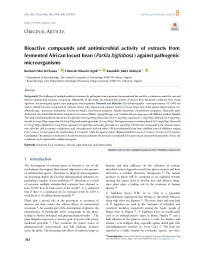Main Article Content
Bioactive compounds and antimicrobial activity of extracts from fermented African locust bean (Parkia biglobosa) against pathogenic microorganisms
Abstract
Background: The challenges of multiple antibiotic resistance by pathogenic microorganisms has necessitated the need for a continuous search for new and effective antimicrobial bioactive compounds.
Objectives: In this study, the antimicrobial activity of extracts from fermented condiment from Parkia biglobosa was investigated against some pathogenic microorganisms.
Materials and Methods: Gas chromatography - mass spectrometry (GC-MS) was used to identify bioactive compounds in n-hexane extract (oil). Aqueous and n-hexane extracts of locust beans were tested against clinical isolates; viz., Klebsiella spp., Aeromonas hydrophilia, Citrobacter braakii, Enterobacter aerogenes, Shigella dysenteriae, Pseudomonas aeruginosa, Salmonella typhi, Escherichia coli, Methicillin-ResistantStaphylococcus aureus (MRSA), Aspergillus spp. and Candida albicans using agar well diffusion method.
Results: The study revealed the phytochemicals in oil as phenols (41.8 mg/100g), flavonoids of 19.37 mg/100g, saponins (16.7 mg/100g), alkaloids (22.9 mg/100g), steroids (6.9 mg/100g), terpenoids (10.0 mg/100g) and cardiac glycosides (3.3 mg/100g). The aqueous extract contains phenols (33.7 mg/100g), flavonoids (12.3 mg/100g), alkaloids (17.6 mg/100g), saponins (5.0 mg/100g) and cardiac glycosides (1.2 mg/100g). The bioactive compounds in the n-hexane extract were ricinoleic acid, p-cymene, octadecanoic acid, n-hexadecanoic acid and others. Oil from fermented locust bean exhibited zones of inhibition ranging from 5 mm to 14 mm against the tested isolates at 10 mg/mL, while the aqueous extract displayed inhibition zones of 4 mm to 10 mm at 10.0 mg/mL.
Conclusion: The chemical constituents in locally fermented condiment (locust bean) are responsible for pronounced antimicrobial properties. Hence, the condiment can be exploited for medicinal purposes.







